RMIT BUSM1162: Analyzing and Building a Problem-Solving Culture Report
VerifiedAdded on 2022/09/07
|8
|1820
|28
Report
AI Summary
This report analyzes the concept of building a problem-solving culture, drawing on insights from various sources including Cook and Jenkins, TEDx Talks, and McKinsey. It explores the key aspects of a problem-solving culture, emphasizing the importance of employee involvement and leadership skills. The report delves into different frameworks such as the 7-step problem-solving process by McKinsey and the SCQR framework, highlighting their application in identifying and resolving organizational issues. Furthermore, it discusses the importance of hypothesis-driven approaches and the need for a structured process to address complex challenges. The report also covers the practical application of these concepts, including the identification of root causes, solution development, and the continuous improvement of problem-solving strategies within an organization. It emphasizes the need for a culture that encourages open communication, standardized work processes, and the alignment of incentives to foster effective problem-solving.
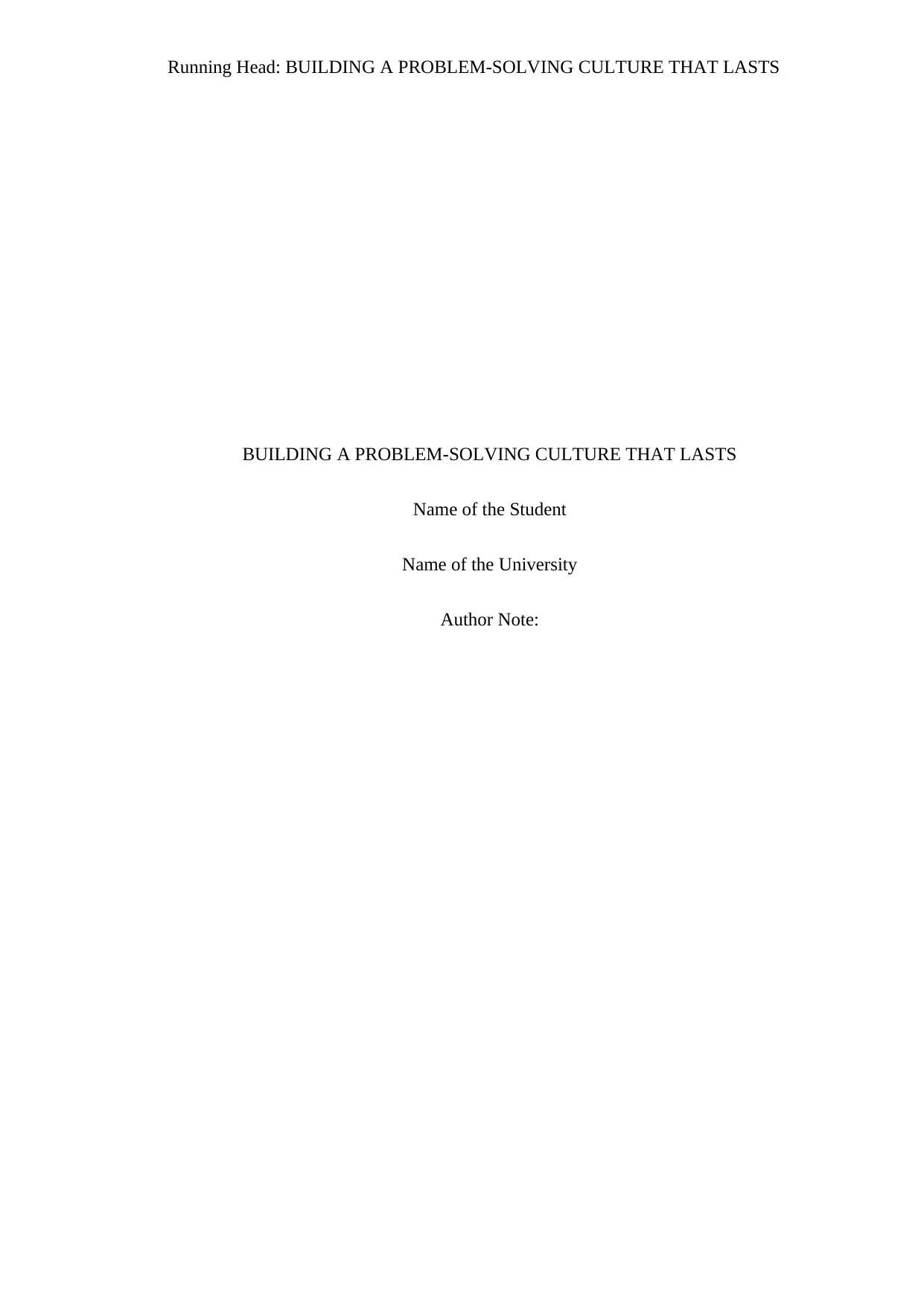
Running Head: BUILDING A PROBLEM-SOLVING CULTURE THAT LASTS
BUILDING A PROBLEM-SOLVING CULTURE THAT LASTS
Name of the Student
Name of the University
Author Note:
BUILDING A PROBLEM-SOLVING CULTURE THAT LASTS
Name of the Student
Name of the University
Author Note:
Paraphrase This Document
Need a fresh take? Get an instant paraphrase of this document with our AI Paraphraser
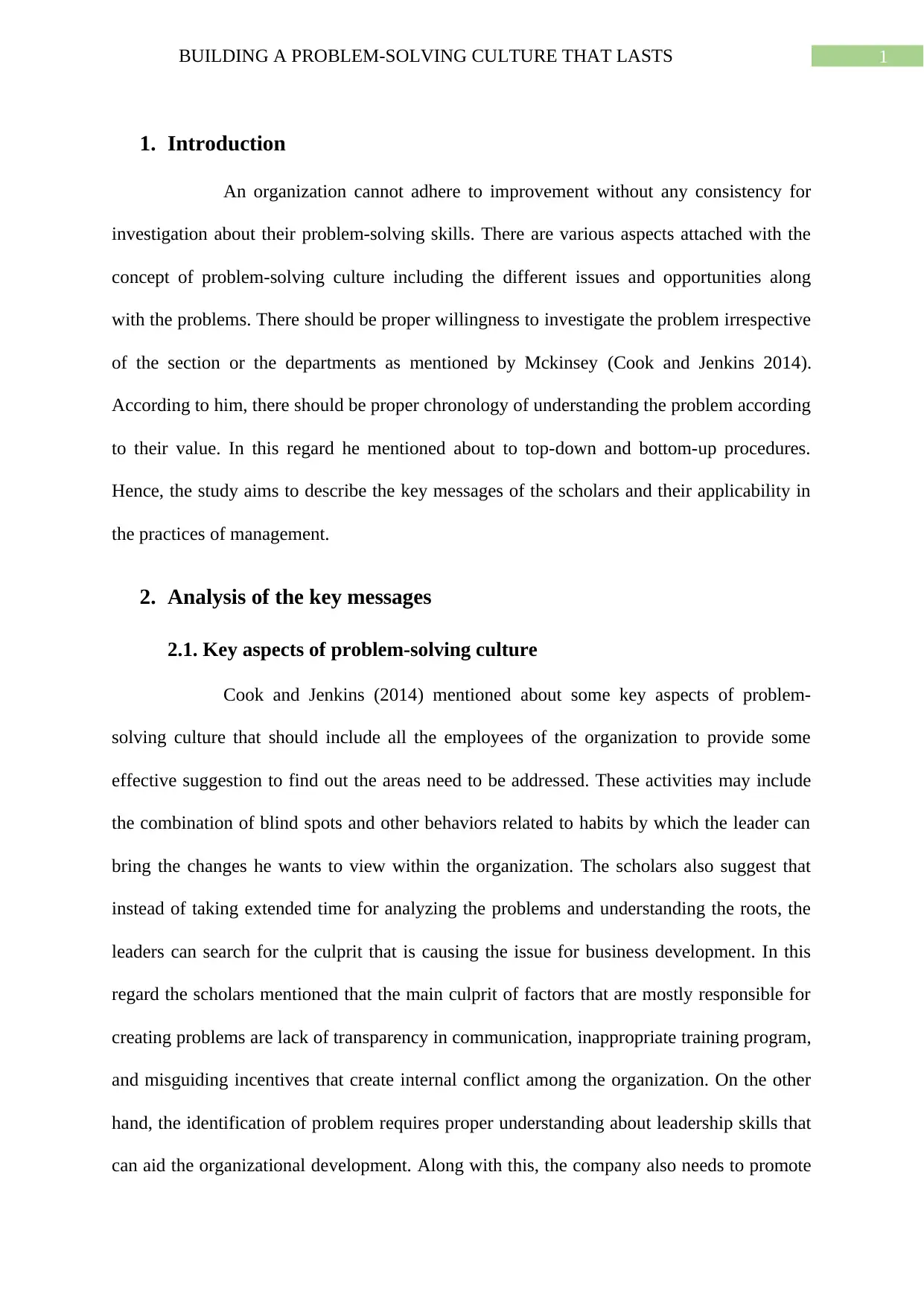
1BUILDING A PROBLEM-SOLVING CULTURE THAT LASTS
1. Introduction
An organization cannot adhere to improvement without any consistency for
investigation about their problem-solving skills. There are various aspects attached with the
concept of problem-solving culture including the different issues and opportunities along
with the problems. There should be proper willingness to investigate the problem irrespective
of the section or the departments as mentioned by Mckinsey (Cook and Jenkins 2014).
According to him, there should be proper chronology of understanding the problem according
to their value. In this regard he mentioned about to top-down and bottom-up procedures.
Hence, the study aims to describe the key messages of the scholars and their applicability in
the practices of management.
2. Analysis of the key messages
2.1. Key aspects of problem-solving culture
Cook and Jenkins (2014) mentioned about some key aspects of problem-
solving culture that should include all the employees of the organization to provide some
effective suggestion to find out the areas need to be addressed. These activities may include
the combination of blind spots and other behaviors related to habits by which the leader can
bring the changes he wants to view within the organization. The scholars also suggest that
instead of taking extended time for analyzing the problems and understanding the roots, the
leaders can search for the culprit that is causing the issue for business development. In this
regard the scholars mentioned that the main culprit of factors that are mostly responsible for
creating problems are lack of transparency in communication, inappropriate training program,
and misguiding incentives that create internal conflict among the organization. On the other
hand, the identification of problem requires proper understanding about leadership skills that
can aid the organizational development. Along with this, the company also needs to promote
1. Introduction
An organization cannot adhere to improvement without any consistency for
investigation about their problem-solving skills. There are various aspects attached with the
concept of problem-solving culture including the different issues and opportunities along
with the problems. There should be proper willingness to investigate the problem irrespective
of the section or the departments as mentioned by Mckinsey (Cook and Jenkins 2014).
According to him, there should be proper chronology of understanding the problem according
to their value. In this regard he mentioned about to top-down and bottom-up procedures.
Hence, the study aims to describe the key messages of the scholars and their applicability in
the practices of management.
2. Analysis of the key messages
2.1. Key aspects of problem-solving culture
Cook and Jenkins (2014) mentioned about some key aspects of problem-
solving culture that should include all the employees of the organization to provide some
effective suggestion to find out the areas need to be addressed. These activities may include
the combination of blind spots and other behaviors related to habits by which the leader can
bring the changes he wants to view within the organization. The scholars also suggest that
instead of taking extended time for analyzing the problems and understanding the roots, the
leaders can search for the culprit that is causing the issue for business development. In this
regard the scholars mentioned that the main culprit of factors that are mostly responsible for
creating problems are lack of transparency in communication, inappropriate training program,
and misguiding incentives that create internal conflict among the organization. On the other
hand, the identification of problem requires proper understanding about leadership skills that
can aid the organizational development. Along with this, the company also needs to promote
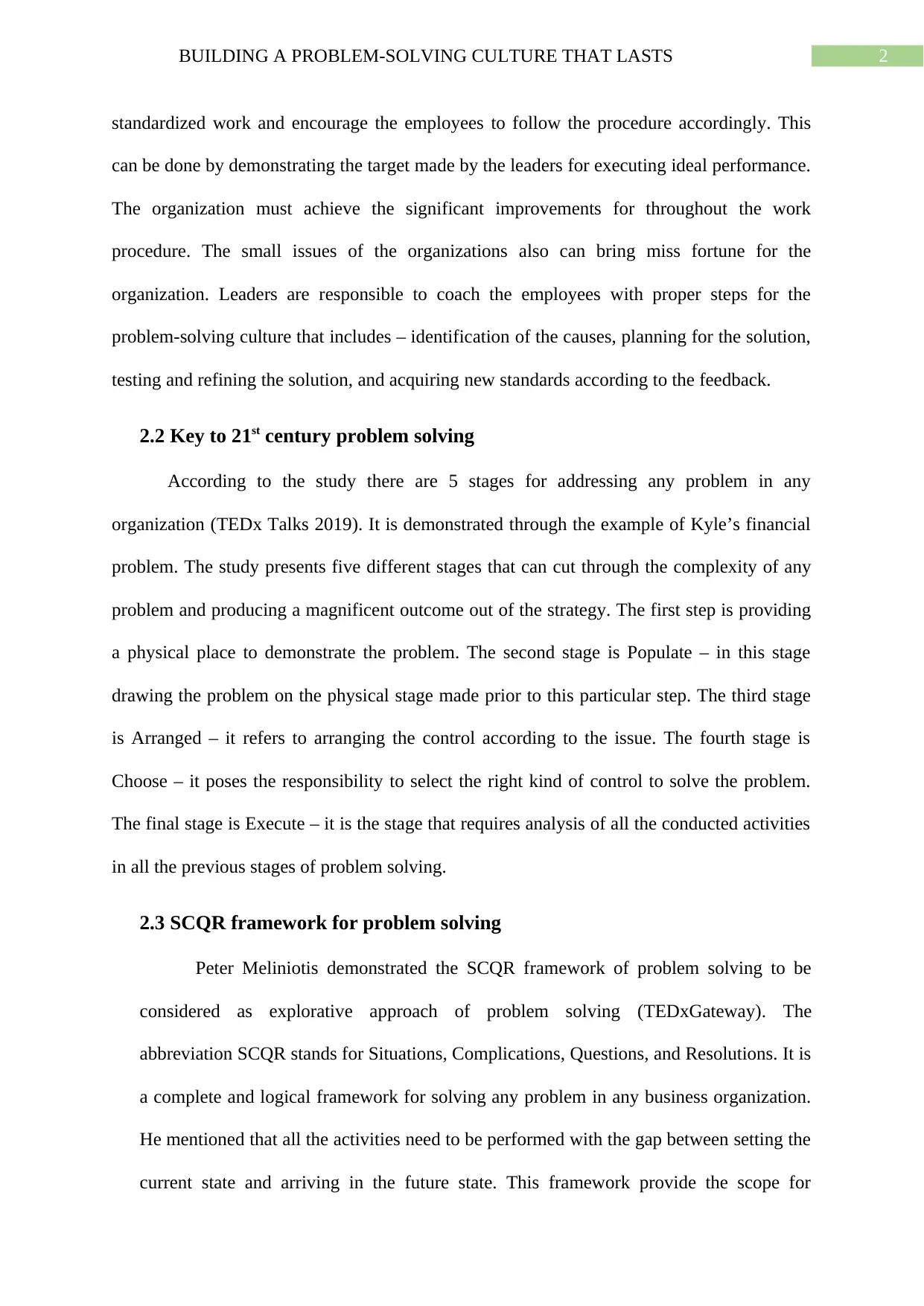
2BUILDING A PROBLEM-SOLVING CULTURE THAT LASTS
standardized work and encourage the employees to follow the procedure accordingly. This
can be done by demonstrating the target made by the leaders for executing ideal performance.
The organization must achieve the significant improvements for throughout the work
procedure. The small issues of the organizations also can bring miss fortune for the
organization. Leaders are responsible to coach the employees with proper steps for the
problem-solving culture that includes – identification of the causes, planning for the solution,
testing and refining the solution, and acquiring new standards according to the feedback.
2.2 Key to 21st century problem solving
According to the study there are 5 stages for addressing any problem in any
organization (TEDx Talks 2019). It is demonstrated through the example of Kyle’s financial
problem. The study presents five different stages that can cut through the complexity of any
problem and producing a magnificent outcome out of the strategy. The first step is providing
a physical place to demonstrate the problem. The second stage is Populate – in this stage
drawing the problem on the physical stage made prior to this particular step. The third stage
is Arranged – it refers to arranging the control according to the issue. The fourth stage is
Choose – it poses the responsibility to select the right kind of control to solve the problem.
The final stage is Execute – it is the stage that requires analysis of all the conducted activities
in all the previous stages of problem solving.
2.3 SCQR framework for problem solving
Peter Meliniotis demonstrated the SCQR framework of problem solving to be
considered as explorative approach of problem solving (TEDxGateway). The
abbreviation SCQR stands for Situations, Complications, Questions, and Resolutions. It is
a complete and logical framework for solving any problem in any business organization.
He mentioned that all the activities need to be performed with the gap between setting the
current state and arriving in the future state. This framework provide the scope for
standardized work and encourage the employees to follow the procedure accordingly. This
can be done by demonstrating the target made by the leaders for executing ideal performance.
The organization must achieve the significant improvements for throughout the work
procedure. The small issues of the organizations also can bring miss fortune for the
organization. Leaders are responsible to coach the employees with proper steps for the
problem-solving culture that includes – identification of the causes, planning for the solution,
testing and refining the solution, and acquiring new standards according to the feedback.
2.2 Key to 21st century problem solving
According to the study there are 5 stages for addressing any problem in any
organization (TEDx Talks 2019). It is demonstrated through the example of Kyle’s financial
problem. The study presents five different stages that can cut through the complexity of any
problem and producing a magnificent outcome out of the strategy. The first step is providing
a physical place to demonstrate the problem. The second stage is Populate – in this stage
drawing the problem on the physical stage made prior to this particular step. The third stage
is Arranged – it refers to arranging the control according to the issue. The fourth stage is
Choose – it poses the responsibility to select the right kind of control to solve the problem.
The final stage is Execute – it is the stage that requires analysis of all the conducted activities
in all the previous stages of problem solving.
2.3 SCQR framework for problem solving
Peter Meliniotis demonstrated the SCQR framework of problem solving to be
considered as explorative approach of problem solving (TEDxGateway). The
abbreviation SCQR stands for Situations, Complications, Questions, and Resolutions. It is
a complete and logical framework for solving any problem in any business organization.
He mentioned that all the activities need to be performed with the gap between setting the
current state and arriving in the future state. This framework provide the scope for
⊘ This is a preview!⊘
Do you want full access?
Subscribe today to unlock all pages.

Trusted by 1+ million students worldwide
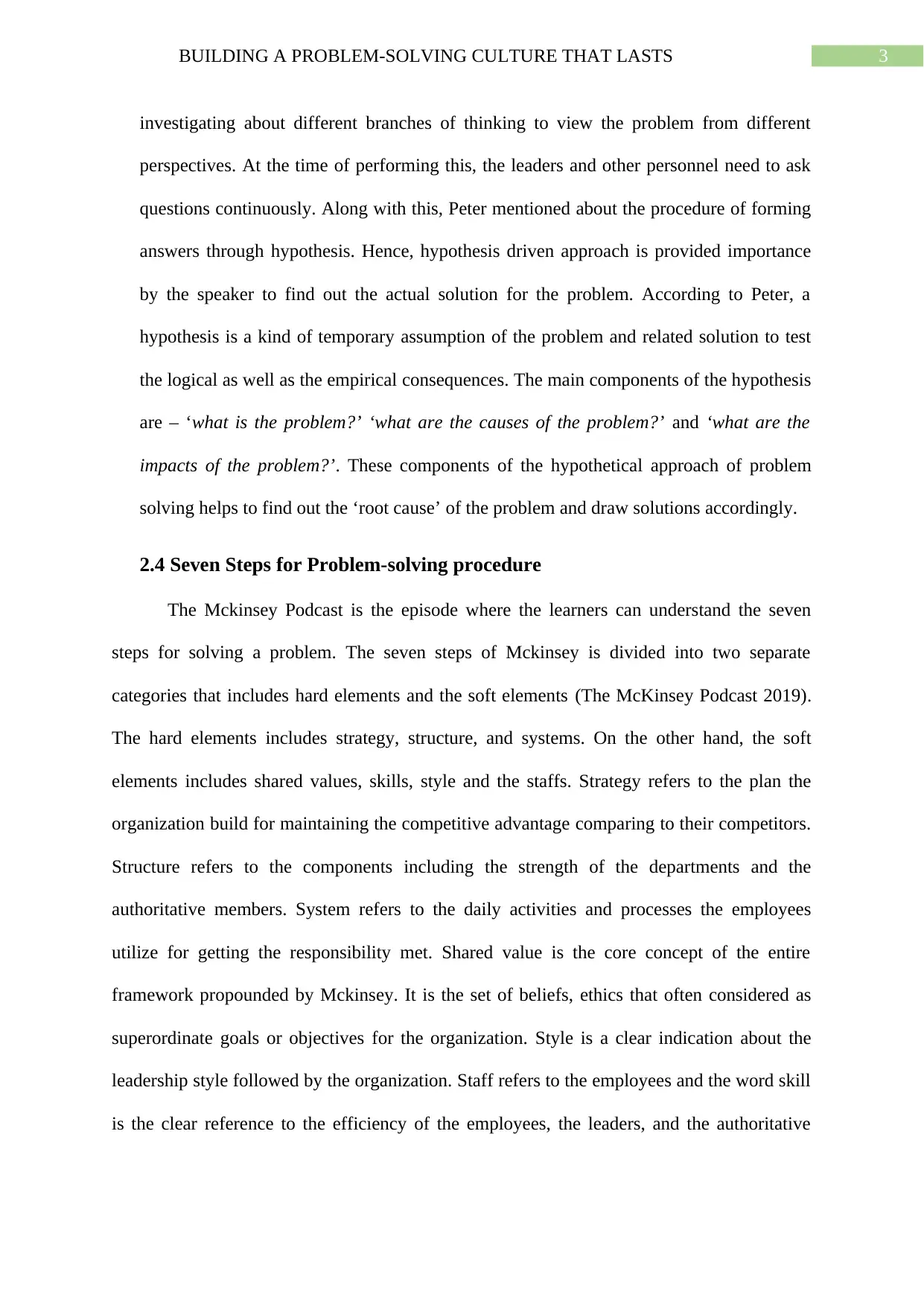
3BUILDING A PROBLEM-SOLVING CULTURE THAT LASTS
investigating about different branches of thinking to view the problem from different
perspectives. At the time of performing this, the leaders and other personnel need to ask
questions continuously. Along with this, Peter mentioned about the procedure of forming
answers through hypothesis. Hence, hypothesis driven approach is provided importance
by the speaker to find out the actual solution for the problem. According to Peter, a
hypothesis is a kind of temporary assumption of the problem and related solution to test
the logical as well as the empirical consequences. The main components of the hypothesis
are – ‘what is the problem?’ ‘what are the causes of the problem?’ and ‘what are the
impacts of the problem?’. These components of the hypothetical approach of problem
solving helps to find out the ‘root cause’ of the problem and draw solutions accordingly.
2.4 Seven Steps for Problem-solving procedure
The Mckinsey Podcast is the episode where the learners can understand the seven
steps for solving a problem. The seven steps of Mckinsey is divided into two separate
categories that includes hard elements and the soft elements (The McKinsey Podcast 2019).
The hard elements includes strategy, structure, and systems. On the other hand, the soft
elements includes shared values, skills, style and the staffs. Strategy refers to the plan the
organization build for maintaining the competitive advantage comparing to their competitors.
Structure refers to the components including the strength of the departments and the
authoritative members. System refers to the daily activities and processes the employees
utilize for getting the responsibility met. Shared value is the core concept of the entire
framework propounded by Mckinsey. It is the set of beliefs, ethics that often considered as
superordinate goals or objectives for the organization. Style is a clear indication about the
leadership style followed by the organization. Staff refers to the employees and the word skill
is the clear reference to the efficiency of the employees, the leaders, and the authoritative
investigating about different branches of thinking to view the problem from different
perspectives. At the time of performing this, the leaders and other personnel need to ask
questions continuously. Along with this, Peter mentioned about the procedure of forming
answers through hypothesis. Hence, hypothesis driven approach is provided importance
by the speaker to find out the actual solution for the problem. According to Peter, a
hypothesis is a kind of temporary assumption of the problem and related solution to test
the logical as well as the empirical consequences. The main components of the hypothesis
are – ‘what is the problem?’ ‘what are the causes of the problem?’ and ‘what are the
impacts of the problem?’. These components of the hypothetical approach of problem
solving helps to find out the ‘root cause’ of the problem and draw solutions accordingly.
2.4 Seven Steps for Problem-solving procedure
The Mckinsey Podcast is the episode where the learners can understand the seven
steps for solving a problem. The seven steps of Mckinsey is divided into two separate
categories that includes hard elements and the soft elements (The McKinsey Podcast 2019).
The hard elements includes strategy, structure, and systems. On the other hand, the soft
elements includes shared values, skills, style and the staffs. Strategy refers to the plan the
organization build for maintaining the competitive advantage comparing to their competitors.
Structure refers to the components including the strength of the departments and the
authoritative members. System refers to the daily activities and processes the employees
utilize for getting the responsibility met. Shared value is the core concept of the entire
framework propounded by Mckinsey. It is the set of beliefs, ethics that often considered as
superordinate goals or objectives for the organization. Style is a clear indication about the
leadership style followed by the organization. Staff refers to the employees and the word skill
is the clear reference to the efficiency of the employees, the leaders, and the authoritative
Paraphrase This Document
Need a fresh take? Get an instant paraphrase of this document with our AI Paraphraser
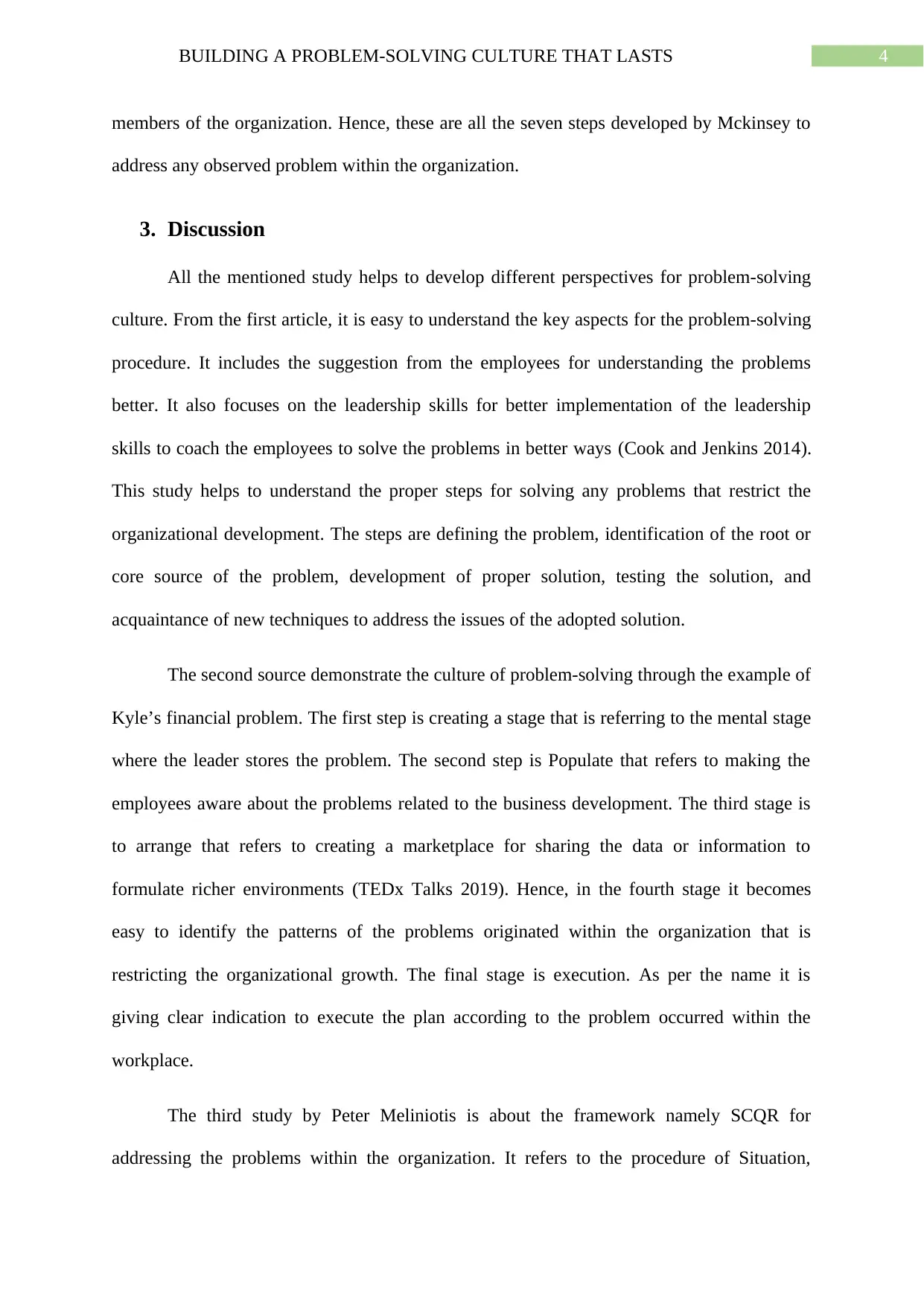
4BUILDING A PROBLEM-SOLVING CULTURE THAT LASTS
members of the organization. Hence, these are all the seven steps developed by Mckinsey to
address any observed problem within the organization.
3. Discussion
All the mentioned study helps to develop different perspectives for problem-solving
culture. From the first article, it is easy to understand the key aspects for the problem-solving
procedure. It includes the suggestion from the employees for understanding the problems
better. It also focuses on the leadership skills for better implementation of the leadership
skills to coach the employees to solve the problems in better ways (Cook and Jenkins 2014).
This study helps to understand the proper steps for solving any problems that restrict the
organizational development. The steps are defining the problem, identification of the root or
core source of the problem, development of proper solution, testing the solution, and
acquaintance of new techniques to address the issues of the adopted solution.
The second source demonstrate the culture of problem-solving through the example of
Kyle’s financial problem. The first step is creating a stage that is referring to the mental stage
where the leader stores the problem. The second step is Populate that refers to making the
employees aware about the problems related to the business development. The third stage is
to arrange that refers to creating a marketplace for sharing the data or information to
formulate richer environments (TEDx Talks 2019). Hence, in the fourth stage it becomes
easy to identify the patterns of the problems originated within the organization that is
restricting the organizational growth. The final stage is execution. As per the name it is
giving clear indication to execute the plan according to the problem occurred within the
workplace.
The third study by Peter Meliniotis is about the framework namely SCQR for
addressing the problems within the organization. It refers to the procedure of Situation,
members of the organization. Hence, these are all the seven steps developed by Mckinsey to
address any observed problem within the organization.
3. Discussion
All the mentioned study helps to develop different perspectives for problem-solving
culture. From the first article, it is easy to understand the key aspects for the problem-solving
procedure. It includes the suggestion from the employees for understanding the problems
better. It also focuses on the leadership skills for better implementation of the leadership
skills to coach the employees to solve the problems in better ways (Cook and Jenkins 2014).
This study helps to understand the proper steps for solving any problems that restrict the
organizational development. The steps are defining the problem, identification of the root or
core source of the problem, development of proper solution, testing the solution, and
acquaintance of new techniques to address the issues of the adopted solution.
The second source demonstrate the culture of problem-solving through the example of
Kyle’s financial problem. The first step is creating a stage that is referring to the mental stage
where the leader stores the problem. The second step is Populate that refers to making the
employees aware about the problems related to the business development. The third stage is
to arrange that refers to creating a marketplace for sharing the data or information to
formulate richer environments (TEDx Talks 2019). Hence, in the fourth stage it becomes
easy to identify the patterns of the problems originated within the organization that is
restricting the organizational growth. The final stage is execution. As per the name it is
giving clear indication to execute the plan according to the problem occurred within the
workplace.
The third study by Peter Meliniotis is about the framework namely SCQR for
addressing the problems within the organization. It refers to the procedure of Situation,
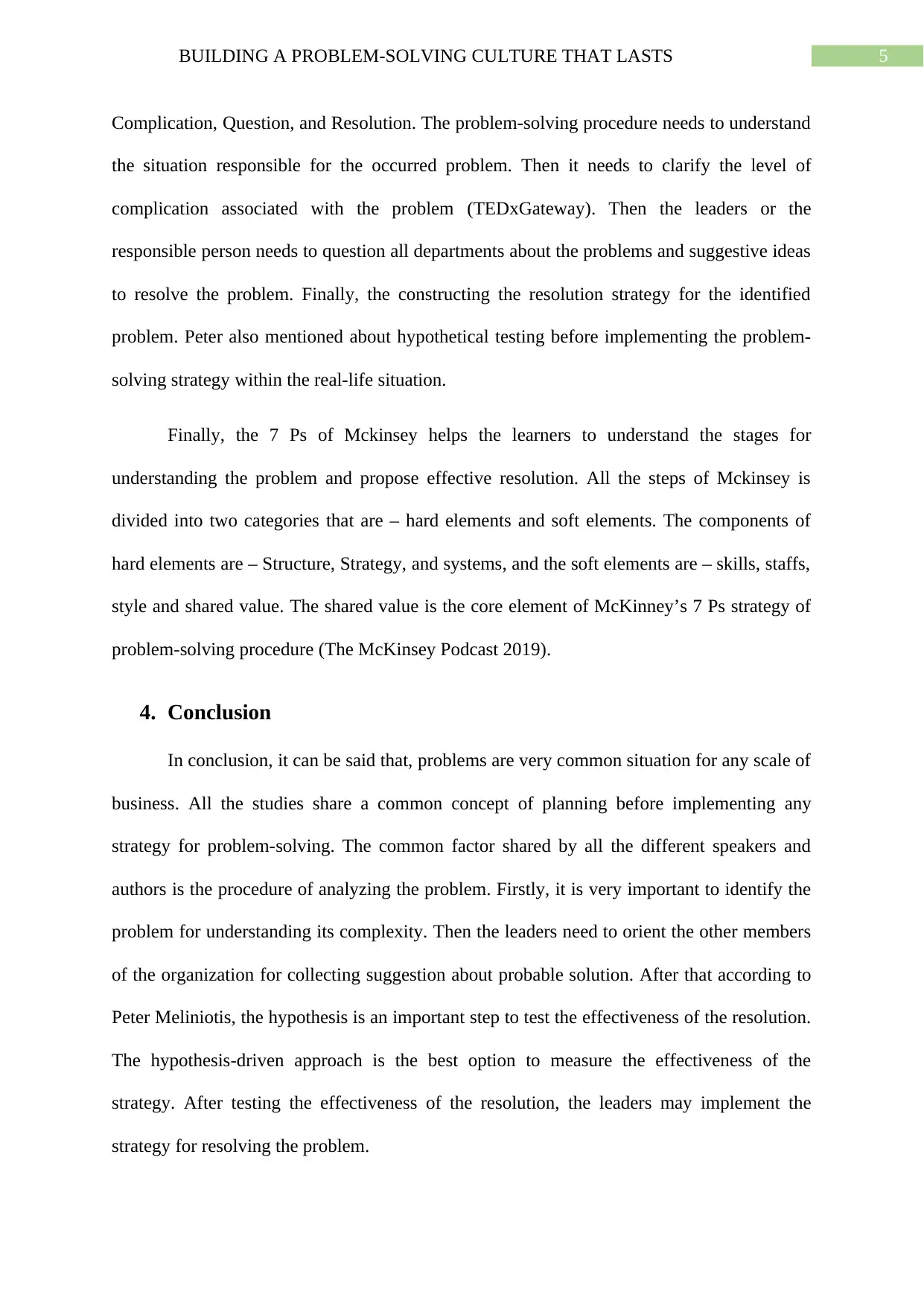
5BUILDING A PROBLEM-SOLVING CULTURE THAT LASTS
Complication, Question, and Resolution. The problem-solving procedure needs to understand
the situation responsible for the occurred problem. Then it needs to clarify the level of
complication associated with the problem (TEDxGateway). Then the leaders or the
responsible person needs to question all departments about the problems and suggestive ideas
to resolve the problem. Finally, the constructing the resolution strategy for the identified
problem. Peter also mentioned about hypothetical testing before implementing the problem-
solving strategy within the real-life situation.
Finally, the 7 Ps of Mckinsey helps the learners to understand the stages for
understanding the problem and propose effective resolution. All the steps of Mckinsey is
divided into two categories that are – hard elements and soft elements. The components of
hard elements are – Structure, Strategy, and systems, and the soft elements are – skills, staffs,
style and shared value. The shared value is the core element of McKinney’s 7 Ps strategy of
problem-solving procedure (The McKinsey Podcast 2019).
4. Conclusion
In conclusion, it can be said that, problems are very common situation for any scale of
business. All the studies share a common concept of planning before implementing any
strategy for problem-solving. The common factor shared by all the different speakers and
authors is the procedure of analyzing the problem. Firstly, it is very important to identify the
problem for understanding its complexity. Then the leaders need to orient the other members
of the organization for collecting suggestion about probable solution. After that according to
Peter Meliniotis, the hypothesis is an important step to test the effectiveness of the resolution.
The hypothesis-driven approach is the best option to measure the effectiveness of the
strategy. After testing the effectiveness of the resolution, the leaders may implement the
strategy for resolving the problem.
Complication, Question, and Resolution. The problem-solving procedure needs to understand
the situation responsible for the occurred problem. Then it needs to clarify the level of
complication associated with the problem (TEDxGateway). Then the leaders or the
responsible person needs to question all departments about the problems and suggestive ideas
to resolve the problem. Finally, the constructing the resolution strategy for the identified
problem. Peter also mentioned about hypothetical testing before implementing the problem-
solving strategy within the real-life situation.
Finally, the 7 Ps of Mckinsey helps the learners to understand the stages for
understanding the problem and propose effective resolution. All the steps of Mckinsey is
divided into two categories that are – hard elements and soft elements. The components of
hard elements are – Structure, Strategy, and systems, and the soft elements are – skills, staffs,
style and shared value. The shared value is the core element of McKinney’s 7 Ps strategy of
problem-solving procedure (The McKinsey Podcast 2019).
4. Conclusion
In conclusion, it can be said that, problems are very common situation for any scale of
business. All the studies share a common concept of planning before implementing any
strategy for problem-solving. The common factor shared by all the different speakers and
authors is the procedure of analyzing the problem. Firstly, it is very important to identify the
problem for understanding its complexity. Then the leaders need to orient the other members
of the organization for collecting suggestion about probable solution. After that according to
Peter Meliniotis, the hypothesis is an important step to test the effectiveness of the resolution.
The hypothesis-driven approach is the best option to measure the effectiveness of the
strategy. After testing the effectiveness of the resolution, the leaders may implement the
strategy for resolving the problem.
⊘ This is a preview!⊘
Do you want full access?
Subscribe today to unlock all pages.

Trusted by 1+ million students worldwide

6BUILDING A PROBLEM-SOLVING CULTURE THAT LASTS
Paraphrase This Document
Need a fresh take? Get an instant paraphrase of this document with our AI Paraphraser
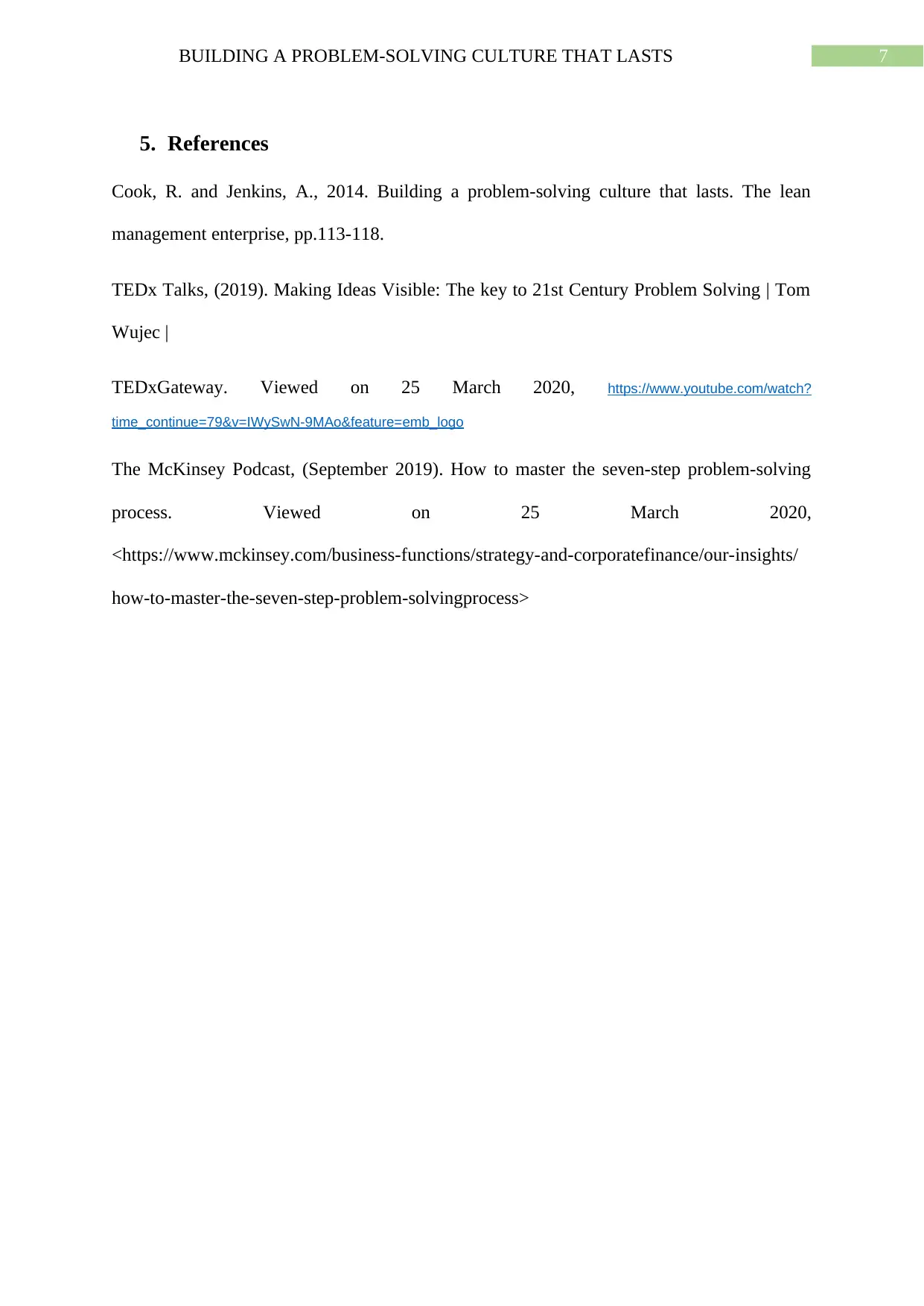
7BUILDING A PROBLEM-SOLVING CULTURE THAT LASTS
5. References
Cook, R. and Jenkins, A., 2014. Building a problem-solving culture that lasts. The lean
management enterprise, pp.113-118.
TEDx Talks, (2019). Making Ideas Visible: The key to 21st Century Problem Solving | Tom
Wujec |
TEDxGateway. Viewed on 25 March 2020, https://www.youtube.com/watch?
time_continue=79&v=IWySwN-9MAo&feature=emb_logo
The McKinsey Podcast, (September 2019). How to master the seven-step problem-solving
process. Viewed on 25 March 2020,
<https://www.mckinsey.com/business-functions/strategy-and-corporatefinance/our-insights/
how-to-master-the-seven-step-problem-solvingprocess>
5. References
Cook, R. and Jenkins, A., 2014. Building a problem-solving culture that lasts. The lean
management enterprise, pp.113-118.
TEDx Talks, (2019). Making Ideas Visible: The key to 21st Century Problem Solving | Tom
Wujec |
TEDxGateway. Viewed on 25 March 2020, https://www.youtube.com/watch?
time_continue=79&v=IWySwN-9MAo&feature=emb_logo
The McKinsey Podcast, (September 2019). How to master the seven-step problem-solving
process. Viewed on 25 March 2020,
<https://www.mckinsey.com/business-functions/strategy-and-corporatefinance/our-insights/
how-to-master-the-seven-step-problem-solvingprocess>
1 out of 8
Related Documents
Your All-in-One AI-Powered Toolkit for Academic Success.
+13062052269
info@desklib.com
Available 24*7 on WhatsApp / Email
![[object Object]](/_next/static/media/star-bottom.7253800d.svg)
Unlock your academic potential
Copyright © 2020–2025 A2Z Services. All Rights Reserved. Developed and managed by ZUCOL.





